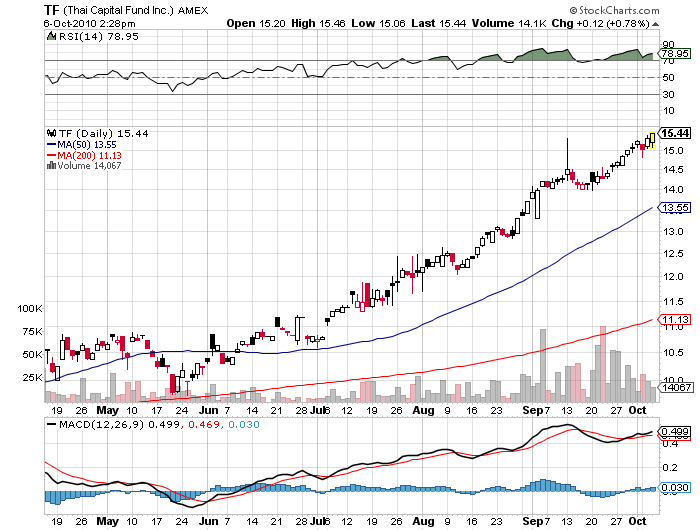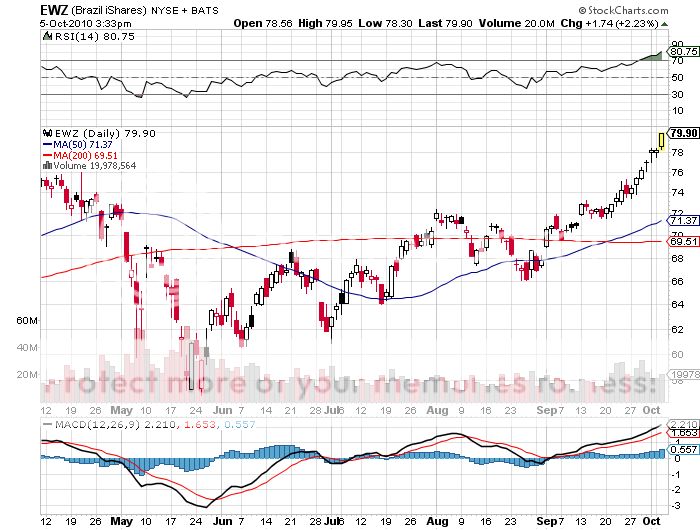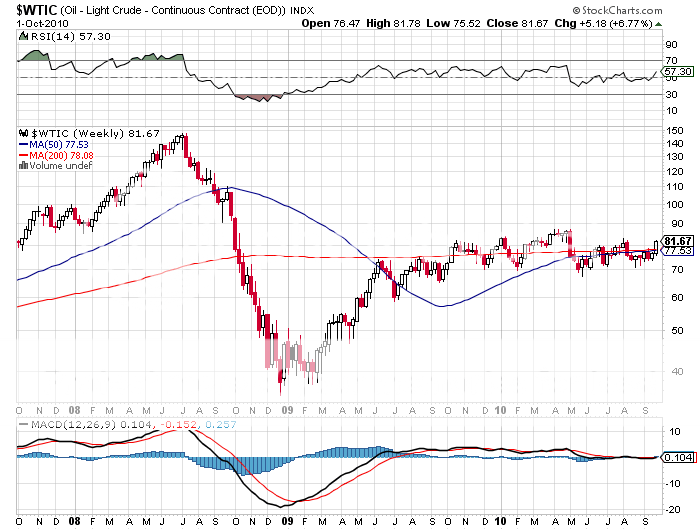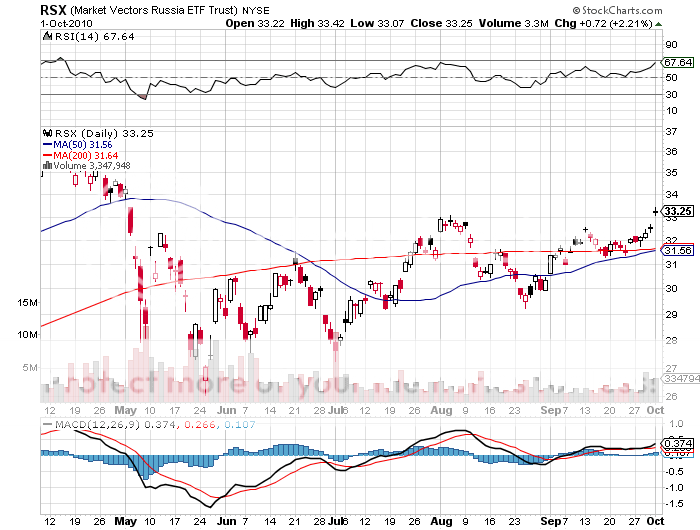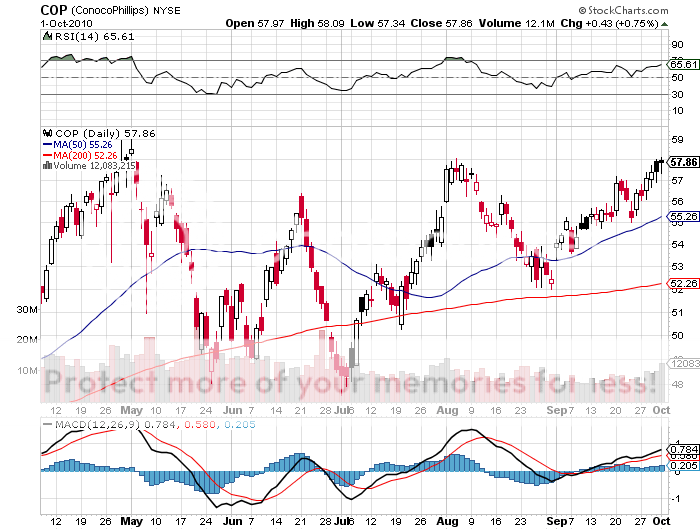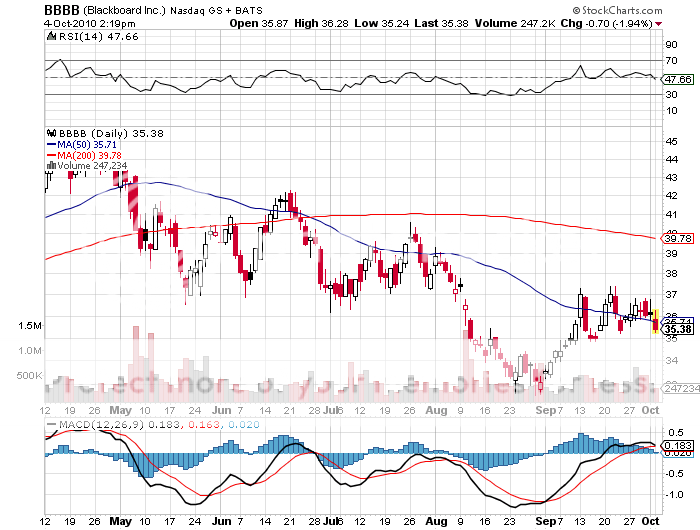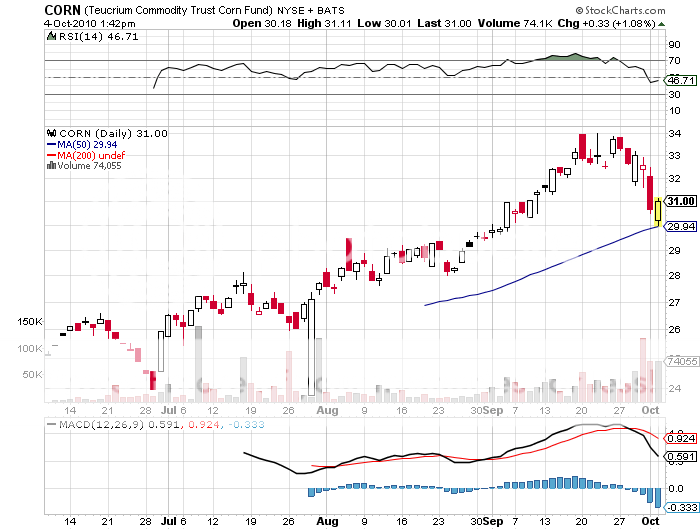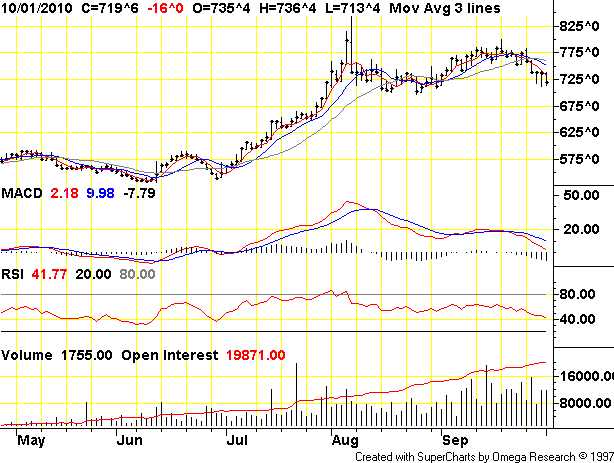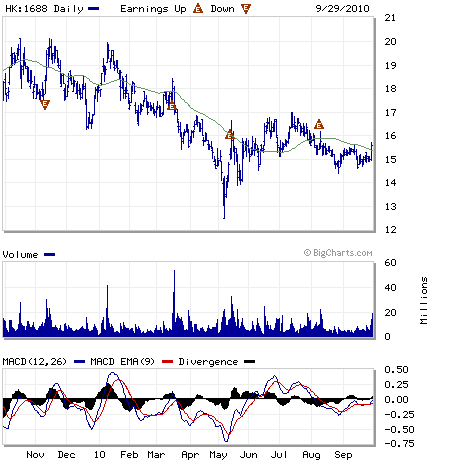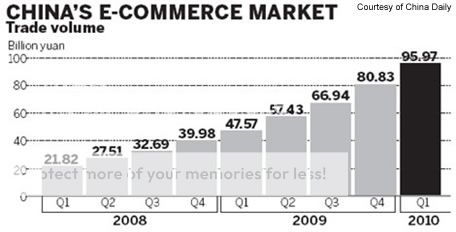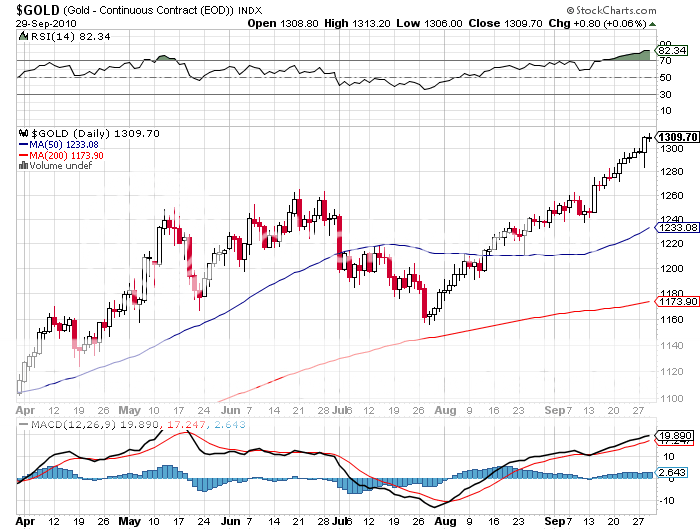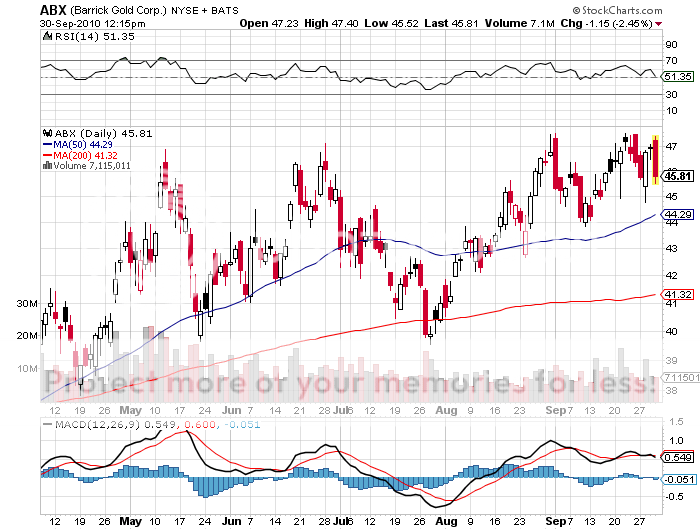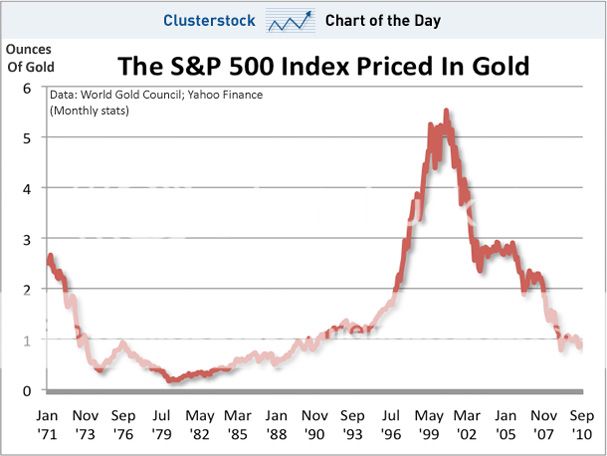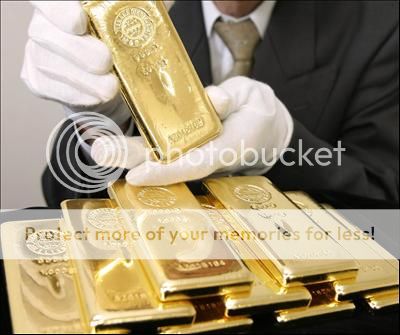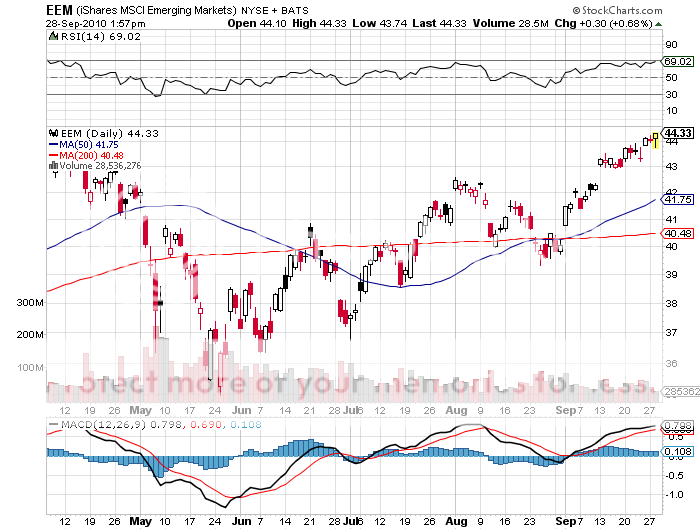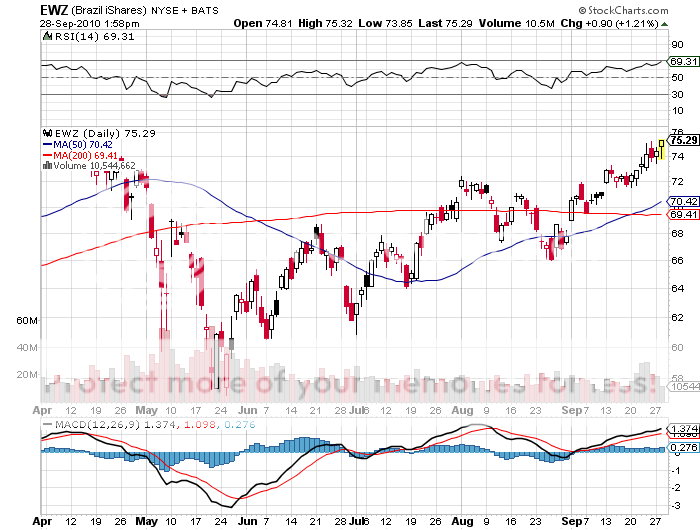
Featured Trades: (THAILAND), (TF)
4) Wow! Have You Seen Thailand? You first heard about Thailand from me in my Hedge Fund Radio interview with Vivian Lewis of Global Investing, back when her pick, the Thai Capital Fund (TF) was trading at $10.75 (click here for the show). Last night it hit an all time high of $15.44, a gain of 44% in less than four months.
Part of the gain can be attributed to an 8% appreciation of the Thai baht against the dollar, which has risen along with most other emerging market currencies (click here for 'Emerging Market Currencies are On Fire'). All they had to do was stop rioting for 15 minutes and it was off to the races, and this was before they even had a chance to rebuild the stock exchange, which they burned down. Maybe the sellers can't find the market's new location?
My inner trader says to take profits after a meteoric pop like this. But people I know on the ground in the Land of Smiles tell me this market is still fundamentally cheap. The multiple is only 11.7, cheaper than surrounding Asian stock markets, despite a 30% rise in corporate earnings in the first half of this year. Exports account for 65% of Thai GDP, which have been on a tear all year. Several big multinationals, like Ford Motors, have announced large new direct investments which I always love to follow.
This is not a riskless trade. The political problems that lead to eight weeks of rioting earlier this year are still simmering below the surface. The government has threatened capital controls, which if imposed, would kill the stock market. A Supreme Court ruling in an anti corruption case later this month could lead to the dissolution of the ruling Democratic Party and reignite the unrest. Maybe the game here is to sell the peace and buy the riots?
Let me Know When You're Going to Riot Again
The ?Friday-Monday Effect? Exposed
Dennis Gartman of the ever interesting The Gartman Letter published an interesting study of the well known ?Monday-Friday? effect. The analysis was done by Andrew Greely of Acorn Derivatives in White Plains, NY. If you bought every Friday close this year and sold the Monday close, your return so far would be 14.20%, versus a 0.42% return on the S&P 500. Virtually all the gains would accrue at the Monday morning gap opening.
If you did the reverse, bought the Monday close and sold the Friday close, then your YTD loss would be 11.00%. Apparently, the market is paying a huge premium for traders willing to run the weekend risk, which during the financial crisis, is when all the disasters occurred. I know of several desks that have been working this trade all year long, with much success. On paper you could have made 25.20% on a non leveraged basis, and less once you take execution and other frictional costs out.
The longer this works, the more who will pile into it, until it blows up, as all of these purely quantitative approaches always do. This is symptomatic of a market dominated by short terms traders, arbs, and hedge fund where the end investor has fled. Expect things to get worse before they get better. By the way, don?t try Googling the word ?exposed?. You?d be shocked, shocked.
To see the data, charts, and graphs that support this research piece, as well as more iconoclastic and out-of-consensus analysis, please visit me at www.madhedgefundtrader.com . There, you will find the conventional wisdom mercilessly flailed and tortured daily, and my last two years of research reports available for free. You can also listen to me on Hedge Fund Radio by clicking on ?This Week on Hedge Fund Radio? in the upper right corner of my home page.
(SPECIAL FIXED INCOME ISSUE)
Featured Trades: (BRAZILIAN BONDS), (EWZ)
2) The Seductive Allure of Brazilian Bonds. OK, let's say that if you don't own bonds, but someone is holding a gun to your head, dangling you by your ankles outside a window on a high floor, or threatening to cut you off their Christmas card list, if you don't buy some. Or worse, you offended you boss's wife at the last office party, and as a result have been put in charge of running the firm's bond fund. What do you do?
There is only one place on the planet I would consider owning bonds right now, and that is in Brazil. Local government one year debt, denominated in the Brazilian currency, the real, is yielding 11.3% . The real is appreciating against the dollar, offering investors a double leveraged effect that will deliver returns above and beyond the coupon. The one year maturity eliminates your duration risk. Inflation is under control at 4.7%. With GDP forecast to grow at 7% a year, the country has a long and merry series of credit upgrades to look forward to.
Capital is pouring in to take advantage of these lofty, double digit yields, with foreign investors snapping up over $5 billion of the $900 billion market this year. These bonds have become especially popular with investors in low yield countries, like Japan, where ten year bonds pay a parsimonious 0.90% a year (that's no typo), and increasingly in the US.
Why are yields so high?? Brazil is still laboring under the weight of its own history, when many of these issuing entities defaulted during troubled times in the seventies and eighties. It turns out that Latin American generals aren't very good at running countries or economies. There is also some concern that growth will become so white hot, that the government would be forced to raise rates to cool inflation, burning bond investors.
If you are a major hedge fund with a 24-hour trading desk in Rio de Janeiro, you will have no trouble picking up a position here, if you haven't already done so. If not, you may have a problem finding paper, as these securities are not to be found in your standard online trading account. If anyone knows better, please let me know.
The only easy way in is through an international bond fund, like the (PCY), which I have been recommending for over a year, with stellar results (click here for the call). The problem here is that Brazil never accounts for more than 10% of these funds, and your gains are diluted by other positions you would rather not have, such as in Greece and Portugal. You could also learn the salsa, become fluent in Portuguese, and pick up a Brazilian girlfriend to get access to the local market. That strategy might offer other advantages as well.
Check Out Those Double Digit Yields in Brazil
Featured Trades: (OIL), (XOM), (CVX), (OXY), (COP), (RSX)
1) Contemplations on Oil.? After a tumultuous 2009, oil has been one of the least volatile assets of 2010, confined to a tortuous $68-$88 range, frustrating momentum players to no end. How many city morgues are packed with the bodies of those who sold every dip and bought every rally, vainly hoping for a break out? By Friday, crude was down 3% on the year, virtually, the only hard asset showing a negative number this year.
Oil traded like it was on Ambien because it spent most of the year discounting a double dip recession. Bloated inventories encouraged hedge funds to build up substantial short positions. Some traders were targeting prices as low as $40.
After last week's sudden burst, it now appears that this crucial commodity is stretching its muscles, limbering up, and getting ready for a serious move. The short position started to go badly wrong in early September. Forecast hurricanes failed to show. Wells in Nigeria, America's third largest foreign supplier, started to explode again. Word has slowly been seeping out that the net effect of the BP oil spill, and the industry curbs that followed, will be a cut of one million barrels a day of Gulf production fairly soon. That is about 5% of the country's total consumption.
Then, Ben Bernanke threatened to launch a hoard of helicopters dumping money on the economy reminiscent of a scene from the classic Vietnam War flick Apocalypse Now, smothering any prospective double dips in the crib. All it took was a surprise plunge in inventories last week, and the short covering was off to the races.
A serious run on the dollar has added fuel to the fire. After running up virtually every hard asset to unimaginable heights in such a short time, investors desperate for returns in a zero return world are now rotating into Texas tea as a laggard. Until Ben Bernanke figures out how to make a barrel of oil with a printing press, money should pour into oil, as it has already into precious metals, industrial commodities, rare earths, and food.
I have always viewed any weakness in oil as temporary, and urged readers to accumulate positions on the cheap on many occasions. This extends to longs in the Russian ETF (RSX), the world largest oil producer and a major exporter (click here for 'Buy Russia When Oil is Cheap').
I must confess that I am an out-of-the-closet, card carrying 'peak oiler', and believe that it is just a matter of time before we punch through the 2008 $150/barrel all time high (click here for 'The Price of Oil is Going Up').
Avoid the ETF here (USO) because the tracking error is so huge. You would be better off buying my picks in the industry on any dips, including Chevron (CVX), ExxonMobile (XOM) (click here for 'Pick up Big Oil While it is Still Cheap'), Occidential Petroleum (OXY) (click here for 'Looking for Value at Occidental Petroleum'), and ConocoPhillips (COP) (click here for ConocoPhillips Looks Like a Steal'.
Pass the Wrench Please, Will You?
Featured Trades: (ONLINE EDUCATION), (BBBB)
2) Say Goodbye to Your Favorite Teacher. Don't bother taking an apple to school to give your favorite teacher, unless you want to leave it in front of a machine. The school teacher is about to join the sorry ranks of the service station attendant, the elevator operator, and the telephone operators whose professions have been rendered useless by technology. The next big social trend in this country will be to replace teachers with computers. It is being forced by the financial crisis afflicting states and municipalities, which are facing red ink as far as the eye can see. From a fiscal point of view, of the 50 US states, we really have 30 Portugals, 10 Italys, 10 Irelands, 5 Greeces, and 5 Spains.
The painful cost cutting, layoffs, and downsizing that has swept the corporate area for the past 30 years is now being jammed down the throat of the public sector, the last refuge of slothful management and indifferent employees. Some 60% of high school students are already exposed to online educational programs, which enable teachers to handle far larger class sizes than the 40 students now common in California. It makes it far easier to impose pay for productivity incentives on teachers, like linking teacher pay to student test scores, as a performance review is only a few mouse clicks away. These programs also qualify for government funding programs, like 'Race to the Top.'? Costly textbooks can be dispensed with.
Blackboard (BBBB) is active in the area, selling its wares to beleaguered school districts as student/teacher productivity software. The company has recently been rumored as a takeover target of big technology and publishing companies eager to get into the space.
The alternative is to bump classroom sizes up to 80, or close down schools altogether. State deficits are so enormous that I can see public schools shutting down, privatizing their sports programs, and sending everyone home with a laptop. The cost savings would be enormous. No more pep rallies, prom nights, or hanging around your girlfriend's locker. Of course, our kids may turn out a little different, but they appear to be at the bottom of our current list of priorities.
The Old School Marm Will Be Sorely Missed
Featured Trades: (CORN), (WHEAT)
3) Welcome to the Limit Down Move. Those who are new to trading the agricultural commodity area, the dilettantes, the neophytes, and the wanabees, who have watched in awe as prices trended skyward for the past four months, may not be familiar with how they behave on the downside.
They got a harsh lesson in reality last week, when corn (CORN) posted a limit down move, the first since January. In my last piece on the ag space, I warned that prices were getting superheated, and that we were only one rainstorm away anywhere in the world from a limit down move (click here for 'Wheat Melt Up Warning'). I therefore advised traders to switch from corn to hard red winter wheat, which had already spent a few months consolidating. That is exactly what we got in Russia a few days later, as one piddling little rain storm provided some respite to the hellish conditions there.
The move proved astute, as corn has recently dropped by 12%, while hard red wheat backtracked only 6%. I often remind readers that this is the market where prices take the stairs up, but the elevator down, and sometimes the window. You only need to work in the industry for 15 minutes before you meet a hapless trader who lost everything he had on one trade, because he didn't exercise such caution.
I still believe that this is just the down payment on a major long term bull market for food (click here for my 'Special Food Issue'). However, you always, always keep stop losses in place to protect yourself from the volatility.
You're Only a Rain Storm Away From a Limit Down Move
Featured Trades: (ALIBABA)
2) Double Click on Alibaba. Given my bullish take on China in my September 28th letter, I'm going to be putting a few more single names out there. Jim Trippon's China Stock Market Digest published a recommendation that caught my eye (click here for my Hedge Fund Radio interview with Jim).
Alibaba (ALBCF) (HKG 1688) is the Middle Kingdom's preeminent e-commerce company, and far and away dominates this fastest growing sector of the economy. In the first half of this year, e-commerce sales in China doubled to $31 billion, and the full year figure is expected to grow to $64.5 billion. So far this year, 36 million have joined the Internet there, bringing the total to 420 million.
Electronics accounted for 44.2% of sales, followed by clothing (17.4%), and jewelry (5.8%). Despite this blistering growth, Internet market penetration stands at only 31.8%, among the lowest in Asia. Deutsche Bank predicts the total market will grow to $220 billion by 2014, while the number of users soars to a mind numbing 812 million, nearly triple the US population! That implies an explosive? 700% growth of the market over a four year period.
Alibaba's profits jumped by 46% in Q2. The stock is not cheap with a PE multiple of 55, but it is almost the only game in town. Despite the amazing outlook for the online industry in China, the stock has fallen for most of 2010, presenting investors with a reasonable entry point. Here is not a bad place to start scaling in. As the ADR's traded on the pink sheets are illiquid, better to buy the Hong Kong traded stock.
More Than All the Clicks in China
Featured Trades: (GOLD), (GLD)
SPDR Gold Shares Trust
3) Gold is Now At the Deep End of the Pool. For me, the best case scenario which I have been predicting for nearly two years has arrived. But as much as I love gold for the long term, I have to take note when a number of short term technical and momentum models start flashing red lights that it is entering extremely overbought levels. The yellow metal has now risen for 12 out of the past 14 days.
Aaron Regent, Barrack Gold's (ABX) CEO, the world's largest gold producer, says he can't imagine ever needing to hedge the company's output again. Not a day goes by without an emerging market central banks making new purchases, with announcements this week coming from India and Sri Lanka. Gluskin Sheff's permabear David Rosenberg, trotted out his own target for the barbarous relic of $3,000/ounce.
Look at the chart below of the S&P 500 priced in gold, and you can only conclude that gold has to reach $10,000/ounce for the ratio to reach the last trough we saw in 1979. Higher predictions are more common than National Rifle Association bumper stickers at a Sarah Palin rally.
I remember all too well when gold last traded like this in that earth-shaking year. Just as I boarded a flight in Hong Kong, my long futures position ticked $750. By the time I landed in Johannesburg 20 hours later, it was trading at $900. I bailed. The fat lady then sang, and gold then bled for 20 years. Investors married to their positions got wiped out.
Traders who stay involved here should do so only against buying cheap out of the money puts for insurance. Remember, this is the commodity that takes the elevator up and the elevator down, and year end book closings are not far off.
Featured Trades: (EMERGING MARKETS), (EEM),
(EWZ), (RSX), (PIN), (FXI)
Brazil iShares ETF
Market Vectors Russia ETF
PowerShares India Portfolio ETF
iShares FTSE/Xinhua China 25 Index ETF
1) The Long View on Emerging Markets. I managed to catch a few comments on TV yesterday in the distinct northern accent of Jim O'Neil, the fabled analyst who invented the 'BRIC' term, and who has been kicked upstairs to the chairman's seat at Goldman Sachs International (GS) in London.
Jim thinks that it is still the early days for the space, and that these countries have another ten years of high growth ahead of them. As I have been pushing emerging markets since the inception of this letter, this is music to my ears. By 2018 the combined GDP of the BRIC's, Brazil (EWZ), Russia (RSX), India (PIN), and China (FXI), will match that of the US. China alone will reach two thirds of the American figure for gross domestic product. All that requires is for China to maintain a virile 8% annual growth rate for eight more years, while the US plods along at an arthritic 2% rate.
'BRIC' almost became the 'RIC' when O'Neil was formulating his strategy a decade ago. Conservative Brazilian businessmen were convinced that the new elected Luiz In??cio Lula da Silva would wreck the country with his socialist ways. He ignored them and Brazil became the top performing market of the G-20 since 2000. An independent central bank that adopted a strategy of inflation targeting was transformative.
If you believe that the global financial markets are back into risk accumulation mode, as I do, then you probably should top up your Brazil position, as it has lagged in the smaller emerging markets so far this year. Jim Chanos, you may be right about a China crash, but you're early by a decade!
It Turns Out He Didn't Wreck the Country After All
Featured Trades: (RESIDENTIAL REAL ESTATE)
2) Pushing on a String Up Close and Ugly. With many economists arguing that Quantitative Easing II amounts to nothing more than pushing on a string, I'll show you what it looks like up close and ugly. The online real estate firm, Zillow.com, has analyzed the results of tens of thousands of recent mortgage applications, with sobering results (click here for their site).
Ben Bernanke can cut interest rates all he likes, but can't raise personal credit scores, and that is a big problem. Some one third of Americans now have credit scores under 620 and are unable to obtain loans under any circumstances. Of the 47% who have good scores over 720, less than half are getting loans at the lowest interest rates. This is important because a mere 20 point improvement in scores leads to a $6,400 drop in the cost of an average conventional loan over its 30 year life.
This won't change until banks return to risk accumulation mode, which is at least five years off. I never miss an opportunity to pile abuse on the residential real estate market, as I believe that for demographic and other reasons it will be dead money for another decade (click here for 'The Hard Truth About Residential Real Estate'). This is just another nail in the coffin.
Not Looking Like a Great Short Term Investment

